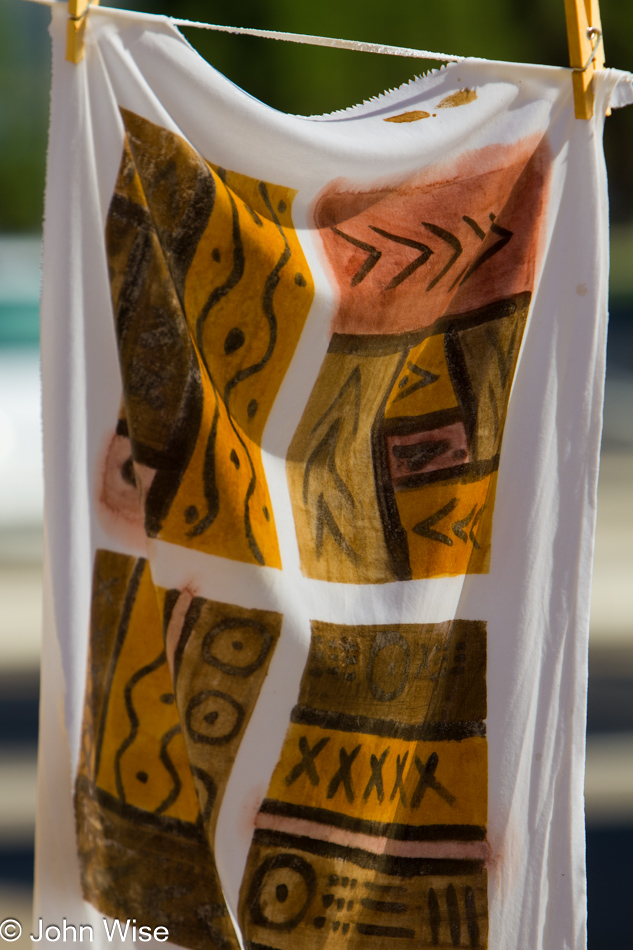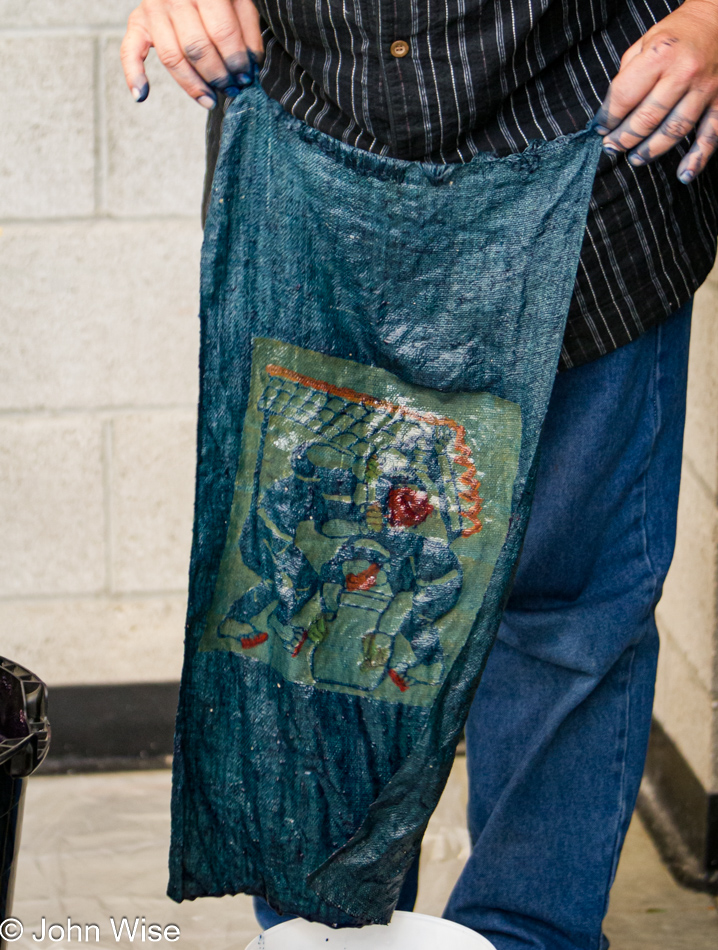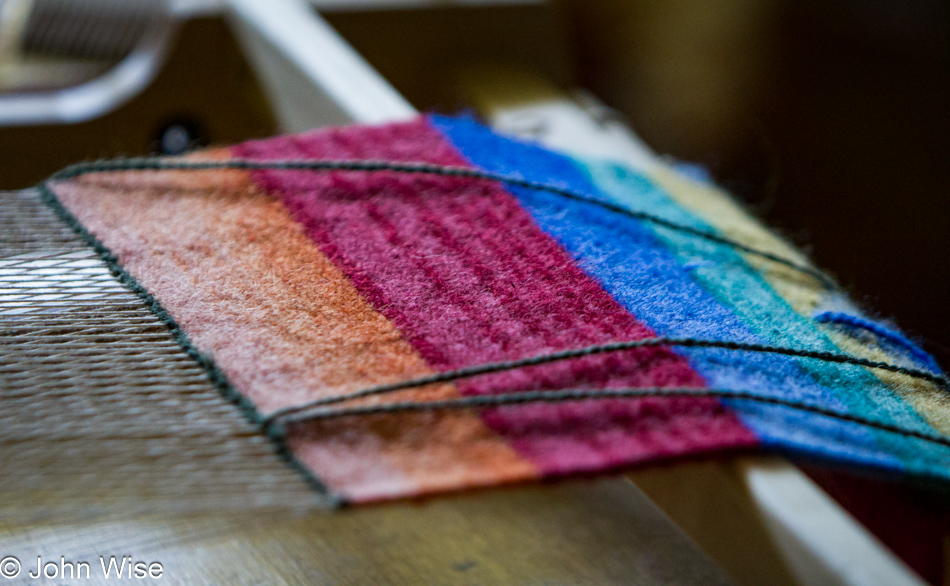
The sun will soon be fully over the mountain horizon behind our camp, but until then, we enjoy our breakfast, watching the calm water of the lake in front of us. By the time the sun is up, we’ll be on our way into town. Stay here a few days, and you’ll have a growing respect for the retirees who drag their 5th wheels and motorhomes out this way to act as camp hosts for the season. For the entire summer, they call this view home.

An early riser out lakeside looking to compliment his breakfast with a fresh trout. I don’t know if he was successful; Caroline and I were in the car about to drive up the hill and around the lake. On the north end of the lake, a wayward pony was walking along the road, seemingly lost and bewildered. I stopped, rolled down the window, and offered the horse a lift, but it just kept on walking, oblivious to us. I admit that the horse didn’t have a thumb out, so I can’t say it was actually hitchhiking, but you never know. The rest of the drive into Durango was uneventful, but we did see a bunch of turkeys in a meadow heading for the forest.

While Caroline has nerves that are able to deal with the trauma of caffeine withdrawal, I have no such inner strength and must heed the call of Starbucks. Like the old steam train above loaded with coal and water, I’m properly tanked up on my espresso shot that was carefully blended with the right amount of steamed soy milk and three splashes of sugar-free hazelnut syrup so that I am now able to take on the tasks that await me. Like a hunting dog distracted by a squirrel, I don’t get far before – “TRAIN!” Does it matter that I already have no less than 83 other photos of the D&S? Of course not; this one could be better than all the rest. But it’s not; I blame it on the jitters of too much coffee. The remainder of my morning into the afternoon was spent photographing the various workshops for the Intermountain Weavers over at Fort Lewis College.

Ever heard of dyeing fabric with mud? Forget your Dolce & Gabbana; we’re going stone age and wearing mud again. I’m not even sure then why we must first put it on fabric instead of just rolling around in the stuff. To be fair, this method of dyeing with mud is called Bogolanfini, a traditional African method – albeit one modified by Judy Dominic. Judy particularly enjoys the inspiration of the designs used by the people of Mali.

Try pronouncing Katazome or Shibori. Katazome is a paste-resist dyeing method using rice paste, soy milk, various pigments, and a lot of indigo. It was this class given by John Marshall here in Durango, Colorado at the campus of Fort Lewis that brought us to the Intermountain Weavers Conference. Every other year, IWC hosts a fiber hoedown that attracts members and non-members alike to spend three days trying new fiber drugs. Trust me, it is not uncommon to hear someone asking to borrow a needle.

John Marshall teaches his students this old Japanese art of Katazome that is quickly disappearing as modern manufacturing processes and the desire for inexpensive clothing make this a dying craft. After the students applied pigments and paste resist materials and probably some other processes in an order I have no clue about, they would dip their work into a vat of indigo. As the cloth is pulled from the indigo, it is still green, as were the leaves that went into the vat that makes indigo.
The magic of indigo happens as the materials are exposed to the air; they begin to oxidize. This oxidation process is what turns the fabric that familiar blue we are all aware of. Depending on what is being dyed, the fabric can turn deep shades of blue, as do fingers and even the hair of one of the ladies in Caroline’s class. Hey Nancy, not sure what I think of blue bangs on white hair, though it wasn’t bad. Maybe this will inspire this grandmother-aged sweet lady to now consider a tattoo of an alpaca with crossed shears. Argh.

After much work and a ton of international coordination, the board members of IWC were able to convince the renowned Scholar, Curator, and Artist Yoshiko Iwamoto Wada to lead a workshop teaching this art form known as Shibori. Ms. Wada not only taught an overflowing class of enthusiastic students, but she was also the Keynote Speaker of the conference. With nothing else going on that night, I stuck around to listen, good thing I did. While fiber arts may not be my specialty, I can certainly appreciate the craft and skill that goes into this work. During the presentation, we learned of the work of a number of artists working in Japan that elicited the oohs and aahs of the overheated theater that reached its seating capacity. Some of the artists who truly made an impression on me were Jurgen Lehl, Christina Kim, and the guys behind Sou.Sou; Tsuyoshi Wakabayashi, Katsuji Wakisaka, and Hisanobu Tsujimura.

Caroline was ready to start dyeing her designs on hemp cloth. With her rubber gloves and apron, there would be no turning her skin or hair blue. John Marshall was pushing his students to complete half a dozen projects, teaching them the art of Katazome.

During my relatively short stay on campus, I took some time to visit all of the classrooms to see what else was on offer. In this class, maybe a dozen people were working on improving their tapestry loom skills. It was also possible this was the first time on such a loom; I didn’t want to disturb the instructors, so I simply stuck my head in, snapped a few photos, and left.

Advancing one’s skills or learning new ones is a goal of these workshops. Here, these two women are working to expand their knowledge of sewing. Maybe this is also an opportunity to rub shoulders with like-minded individuals and get away from spouses who may not be exactly supportive of these hobby crafts. The most striking aspect of my short visits to these events is the camaraderie exhibited between attendees. There is no hesitation to share tips and tricks; there is no bragging about statistics that put one person in a bragging position where their expertise creates celebrity – most of the time!

The grounds of Fort Lewis are spread out, although it may have only felt that way because Durango sits at 6,512 feet above sea level (1984m). On one end of the campus was the Student Union building, where check-in, the cafeteria, and merchants were located. In a nearby building, five or six classes were being held; next door to that was the theater. On the way north across campus was another building where a few classes were taking place, followed by the Arts building where Caroline’s class and five others were going on. At the far north, a juried fiber exhibit was taking place.
This is an example of the final outcome. Spend years perfecting the techniques that broaden the ability to discern the beauty in patterns and then deploy those skills to inspire your fellow artists. This handwoven shawl was on display in the non-juried Intermountain Spirit exhibit, with attending members encouraged to submit their best work, too.

My vote for best of show would have been this handwoven basket. The irregular shape and southwest mountain colors with a fine band of green glass beads really worked for me. And people think basket weaving is a boring chore for retirees with nothing better to do, as though staring at a small screen and tapping out messages in 140 characters or less is a statement of the pinnacle of sophistication people have attained. Do I sound bitter about the neglect of our skills, intellect, and respect for those who learn? Well, I guess I am – oh, how I wish humanity would find its next renaissance.

The culmination of Caroline’s efforts at the Intermountain Weavers Conference 2011 event in Durango, Colorado. Next year, she will likely attend Fibers Through Time 2012 to be held in Phoenix, Arizona. If we are still living in the southwest the following year, I wouldn’t imagine it as being too far a stretch that she will once again find herself in Durango attending IWC 2013.

When that part of the day was finally complete, Caroline and I made our way back to the lake for our final dinner to be enjoyed on the dock. Up for tonight’s dining pleasure: mixed beans with Grand Canyon-style Dutch oven-baked green chili, corn, and cheese cornbread. We toasted the fun getaway with some sparkling cider. Word of warning: we dragged this bottle of Martinelli’s from our refrigerator in Phoenix (elevation of about 1100 feet) to this lake (elevation of approximately 7600 feet) and popped open the bottle with no idea that I would be wearing a quarter of the sparkling apple cider as the pressure release jettisoned off a nice glass full of juice from my knees to my chin. Laughter made for a great appetizer.